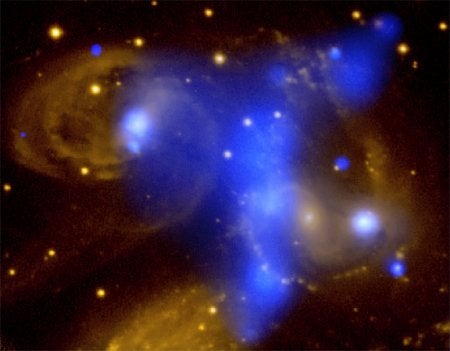The Chandra X-ray Observatory has imaged a shock wave between the tightly knit galaxies known as Stephan’s Quintet. Optical images do not reveal the 6-million-degree-Celsius gas that was created when the spiral galaxy NGC 7318b punched through the area.
This is not the first time Stephan’s Quintet has been punctured by a forceful galaxy. The x-ray image shows evidence that the small spiral galaxy NGC 7320c plowed through the region several hundred million years ago. This disruption created the tail of stars that leads away from the spiral galaxy NGC 7319. NGC 7320c may have intruded on the quintet more than once, and it is now keeping its distance 460,000 light-years from the others.
The brightest galaxy, NGC 7320, is only visually connected to the quintet by a line-of-sight coincidence. It actually lies 35 million light-years from Earth, whereas the other members all lie about 280 million light-years away. However, the group can still be counted a five-some when the frequent intruder NGC 7320c is included.
The chaotic movement of the galaxies and their gravitational pulls are removing cool gas, which is the raw material for the formation of new stars. Therefore, in a few billion years the spirals of Stephan’s Quintet will settle into a rounded-out group of elliptical galaxies.
Stephan’s Quintet may look familiar to the lay person because it is featured in the classic 1946 holiday movie It’s a Wonderful Life as a group of conversing heavenly angels. Stephan’s Quintet is the prototype of a compact group of galaxies and was discovered by French astronomer Edouard M. Stephan in 1877. He first spied the group with the 40-centimeter refracting telescope at the Observatory of Marseilles. Located in the constellation Pegasus, Stephan’s Quintet is also known as Hickson 92, Arp 319, and VV 228.










